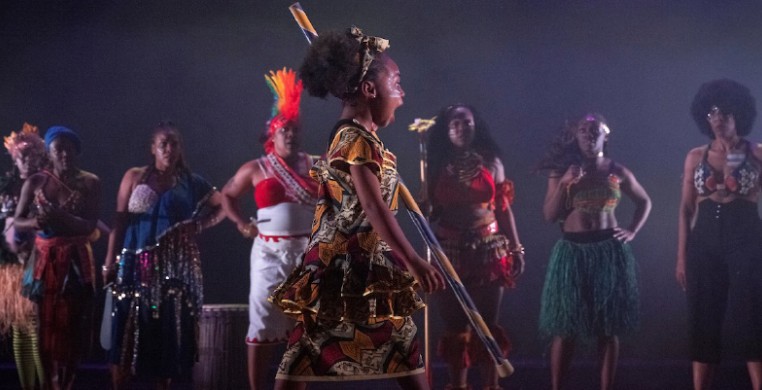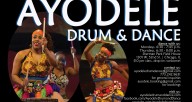UPDATE: The new seechicagodance.com will launch March 31st. Click here to learn more.
Ayodele Celebrates the Continuum of Queens in HerStory II Tell: Femmes de Pouvoir
First, I love Ayodele Drum and Dance! If you’ve ever been to one of their weekly community classes, you will notice everyone is welcome from babies, to elders, to significant others. The classes are truly an intergenerational and inclusive community, a way of life integral to our well-being and necessary for our nourishment. The word Ayodele, means “joy in the home” or “joy has returned home” in Yoruba (a West African language spoken mainly in South Nigeria). With a wide variety of community engagement opportunities from classes, performances, conferences and more, it is clear Ayodele Drum and Dance has blossomed into much more than a dance company since its inception in 2007. Ayodele is a village, emanating an energy that welcomes every visitor and recognizes women as the “queens” they are, reminding us that within this village, we are always at home.
On Saturday, May 7th, multiple generations touched by Ayodele’s energy eagerly assembled into the smoky performance hall on Mother’s Day weekend at the Logan Center for the Arts. The much-anticipated “Herstory II to Tell: Femmes de Pouvoir”, written, choreographed and directed by fierce Ayodele Founder and Executive Artistic Director Iyawo Shango T. Ayo, was sure to be a performance to remember. Founding Ayodele “Queen” and Business Manager Mashaune Hardy appeared through the purple-tinted fog offering a high-spirited welcome that matched the inviting energy that we have come to know as Ayodele, reminding us that this evening was indeed special.
In the introductory entrance of the “Queens and their Tribes”, we were taken on a powerful journey celebrating the life and work of eight “Queens” throughout the African Diaspora: Queen Nanny, Harriet Tubman, Funmilayo Ransome Kuti and Amaniyea Payne were just a few of the revolutionary women recognized throughout the introduction and evening. Narrated by three young actors from Chicago Academy of the Arts (ChiArts), the grand opening was further elevated by each “Queen’s” larger-than-life photograph projected on the background screen. Shifting admirably between playing doun doun drums and West African dancing, each “Queen” prepared us for the journey of her strength, beauty and wisdom; ultimately gifting us with “HerStory” to tell.
As I think about the entire evening, my mind first goes to the living tribute that gave flowers to the beloved former Artistic Director of Muntu Dance Theatre of Chicago, “Queen” Amaniyea Payne. Choreographed by Imania Detry and danced by what we later learned were the “Fantastic Four” ( Imania Detry, Iyawo, Ayo, OsunKoya Odum and Naomi Kinslow), the piece was guided by a melodic jazz tone paying homage to what appeared to be lamban and other traditional forms of West African dance. The “Fantastic Four” were once inseparable as they were mentored through African Dance by Payne. Saxophones reeled us in circular patterns as each dancer rocked their own style; a fabulous 20s style red fringe leotard for one, a rainbow feather headdress for another. Each dancer, a powerhouse in her own right, performed in syncopated union with distinct flair. As they collectively paid tribute to Payne, a stream of memories flashed on the background scrim. I cried. Witnessing precious moments of Payne and snippets of the many lives she transformed through African Dance in Chicago and the world. Illustrating the bond that could only be created with time, sweat, dedication and tears, it was clear each dancer had a story and each raise of the palms was a thank you. The moment became even more special, when Payne gracefully came onstage and received the dedication, returning her gratitude for the ever-flowing continuum of African Drum and dance leaving us with sage words, ““As you lead, they follow and as they follow, they continue to lead.”
In an earlier piece, I was energized by the buoyancy of the tribute to “Queen” Funmilayo. Described by many as the “Lioness of Lisabi,” Funmilayo was a Nigerian educator, activist and suffragist who organized some of the first literacy programs for lower income women in Nigeria. Represented by Xantia Grant and the fiery Ayodele Teen Queens ensemble, dancers weaved seamlessly in and out of windows wowing us with whipping afros, somersaults and explosive energy fluently articulated by Senegambian and Guinean rhythms. With a riveting performance that resonated to the furthest seats in honor of Kuti, the accumulated energy was so high, the audience thrusted themselves to a standing ovation at the end of this piece. I thought, “Wow, what a magical finale!” However, we were only at intermission, the show had just begun!
Furthering the legacy of female empowerment were the Ayodele Youth Program Dancers who were the youngest carriers of the African Drum and Dance legacy in the Ayodele Village. Tubman played by Imara Moore was danced by both Ayodele Youth Programs and the Teen Queens. Wooden arrows and reverse pyramids stand out in my mind, speaking to critical natural elements such as bird migration and polaris, a trinary star in the star system. All of which Tubman utilized to free enslaved people to the North. The audience was tickled often by the appearance of a young Tubman, dressed in a gold-like gown with a stick, projecting her presence and voice on many occurrences throughout the program. Tubman reminded us of her perfect track record and to never overlook the leadership of the young people. I strong clapped and gave a couple “Go ‘head girls!” to the Ayodele Youth that were on fire, especially Zaahirah O’Neal who was dancing like she’s been here before.
Ayodele principal performers, apprentice performers and apprentice studies showed all the way out! Serving as the heartbeat for the performance. Their mastery and endurance brought the audience to their feet, moving us to shout and toss offerings on the stage and question our entire existence. Senegalese, Guinean, Ghanain and Ivory Coast rhythms were just a few of the West African rhythms played. We were elevated to other realms each time a new “Queen” was introduced. At times a crimson-red adorned “Queen Abla Pokou” (played by Contessa Green, werrkked! Commanding the full attention of the audience with her mesmerizing hip circles rotating to the Banty rhythm of the “We people from Ivory Coast.” In many of the pieces, especially “Warriors Gotta Eat,” the dancers unapologetically pulled out their full arsenal, dancing not only with their entire beings but also with various weapons of protection from knives to swords, to arrows and AK47s. Each revolutionary was a fierce warrior known to defend their land, people and sovereignty by any means necessary.
Dispersed in between rigorous Fungama war dances and Konkoba Guinean rhythms and dancing was a refreshing moment of men dancing in the Ayodele Village. There was a lighthearted fun with a battle of the “Queens vs. Kings” that ultimately ended in a vignette of love affairs. I also enjoyed the collaborations with Columbia College Dance Department and Chi-Arts with the humor of the Chi-Arts students script and the jazz, lyrical and modern style brought by the Columbia dancers. The unions brought another spirit to the performance and helped to shift gears.
Overall, the evening was ripe with inventiveness, explosive energy and homage beautifully illustrating the worlds within each warrior while inspiring an entire village to step into their power. The continuum of teaching, learning and inspiring was not confined to the stage. The spillover left an impact on us all, encouraging us to be bold and brave and most importantly ourselves.


